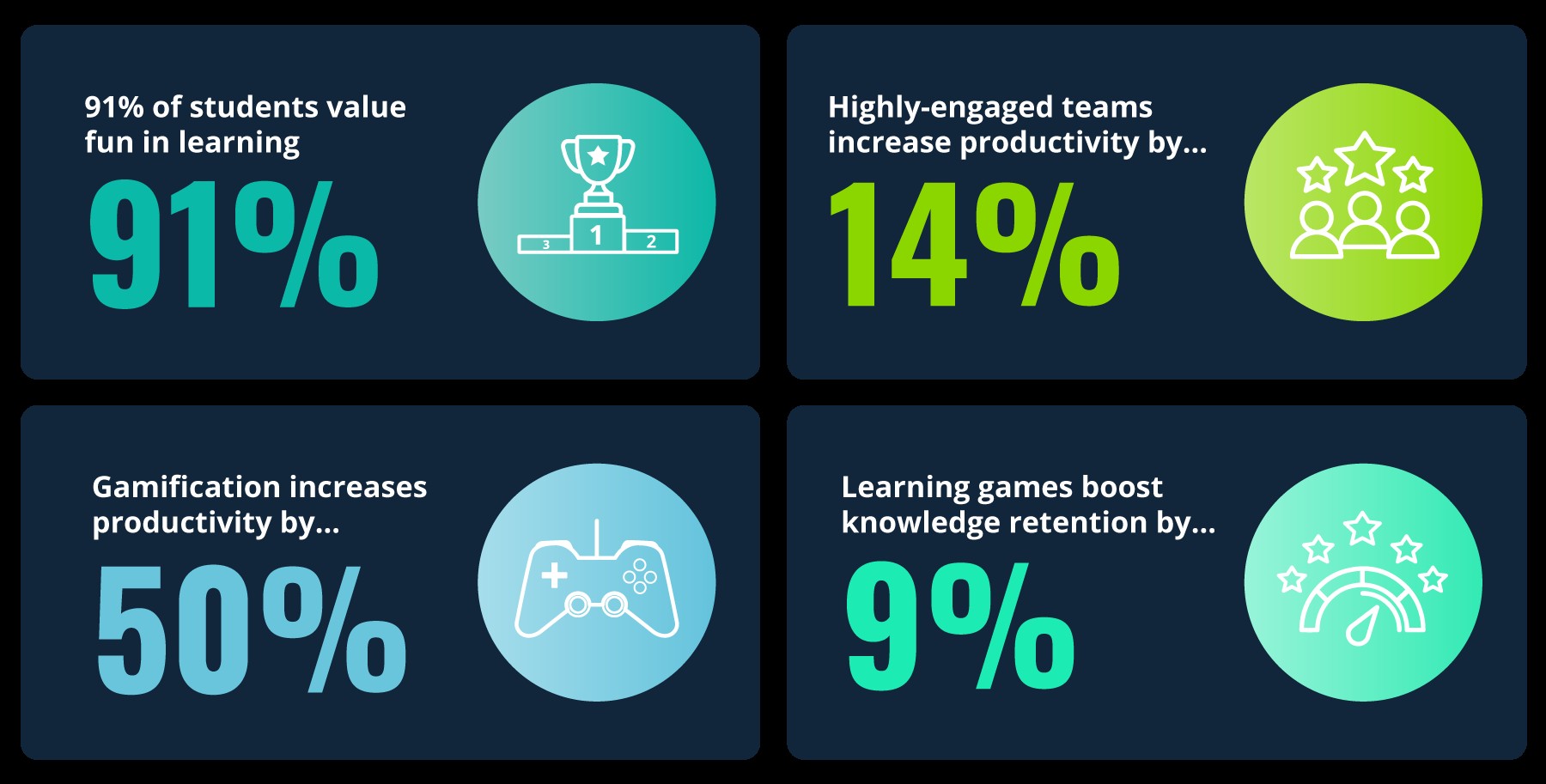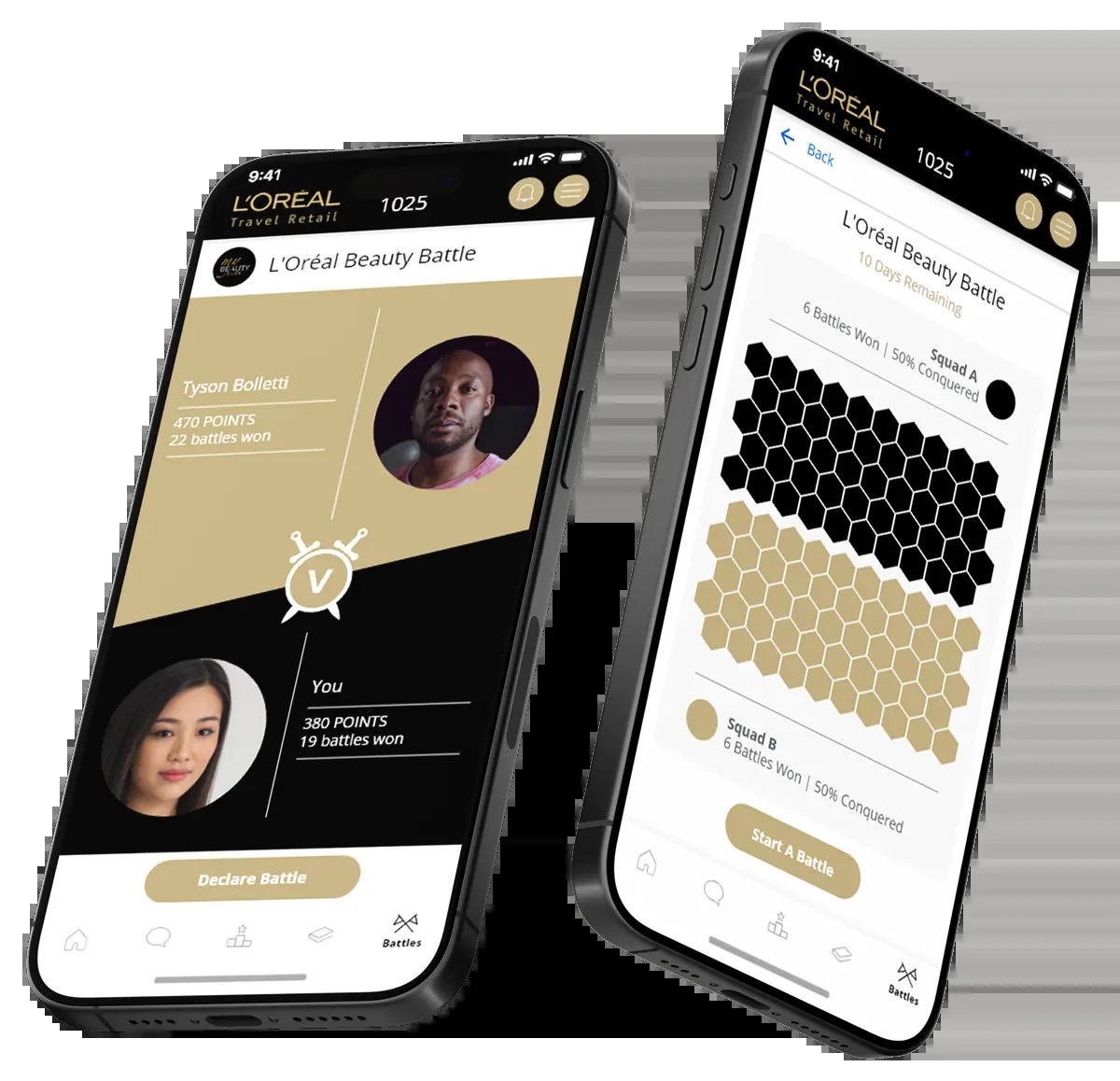Having fun in learning is crucial for engagement and retention, fostering a positive environment where knowledge is absorbed with enthusiasm. At LEARNS.EDU.VN, we understand the power of enjoyable education, offering innovative methods to transform learning into an exciting adventure. Discover how to make learning a joyful experience, enhancing both understanding and long-term memory, while fostering a thriving learning culture, and enabling self-directed study for continuous development.
1. The Science Behind Enjoyable Learning
Research overwhelmingly supports the idea that enjoyable learning enhances knowledge retention and boosts productivity. Studies show that 91% of learners value fun in learning, with gamification improving company productivity by up to 50% and learning games increasing knowledge retention by 9%. Teams with engaged learners are 14% more productive. This demonstrates that fun has a profound positive impact on learning effectiveness.
Here are some key findings that highlight the importance of fun in learning:
- Increased Engagement: Enjoyable learning experiences capture learners’ attention and keep them motivated.
- Improved Retention: When learning is fun, information is more likely to be retained in long-term memory.
- Enhanced Productivity: Engaged learners are more productive and perform better in their tasks.
Judy Willis, a neurologist, explains in her book how fun experiences increase levels of dopamine and endorphins in the brain, both essential hormones for successful learning. Dopamine, known as the ‘feel-good hormone,’ makes learning pleasurable and rewarding, while endorphins help manage stressful situations. A positive mood enhances the perceived value of rewards, including the gratification from learning something new or acquiring a new skill.
Aditya Shukla notes that positive emotions broaden our attention capacity, helping us draw mental resources, increase access to memory networks, and motivate efficient thinking.
2. Why Is Enjoyable Learning Important?
A learning journey filled with excitement and engagement is far more effective than one perceived as dull or tedious. Injecting elements of enjoyment into the learning process can lead to significant benefits:
2.1. Boost Learner Productivity
A fun working environment makes us happier at work, significantly influencing organizational outcomes. Happy employees are 12% more productive. A good laugh makes us more productive and resilient. Incorporating light-hearted elements can provide motivation for challenging projects and tight deadlines.
2.2. Reduce Absenteeism
Research indicates that 62% of individuals who engage in fun activities at work take no sick days in the subsequent three months, compared to only 38% of those who do not participate. Organizing fun activities and creating a relaxed, supportive company culture can reduce recruitment costs.
2.3. Enhance Resilience
Resilience is crucial during times of adversity, whether facing a business crisis or a bad day. Fun and laughter can help lower stress and boost immunity. Muscles relax for up to 45 minutes following a good laugh. Promoting a positive office culture that encourages fun and laughter helps protect staff against the stresses of daily working life, creating a more resilient workforce.
2.4. Foster Creativity
Without a little fun, people become dull and uninspired, stifling creativity. 55% of staff who have participated in a fun activity in the last six months feel more creative. A workplace where people feel free to laugh encourages them to share ideas freely, fostering a culture where ideas bounce back and forth effectively, making a significant difference in business innovation.
2.5. Cater to Diverse Learners
Fun means different things to different people. 79% of millennials think fun at work is important, compared to just 55% of older generations. Only 14% of business owners see dress-down days as fun, compared to 29% of graduates. Business owners are also less likely to value fun at work than employees. Asking your people what they want when planning company wellbeing strategies, staff conferences, or social events fosters inclusion, diversity, a sense of epic meaning, and lots of fun.
2.6. Cultivate Fun as a Habit
While one-off away days, team events, or socials can temporarily boost morale, fun needs to become a habit to translate into happiness and success. Fun-focused events and activities should occur regularly. Integrating fun into your company and learning culture keeps staff happy, engaged, and motivated.
3. Overcoming Barriers to Enjoyable Learning
Despite the recognized benefits, many organizations struggle to integrate enjoyable learning into their culture. Understanding these barriers is the first step in addressing them:
Here’s a table that illustrates common challenges and potential solutions:
| Challenge | Potential Solution |
|---|---|
| Association of education with traditional, rigid methods | Incorporate gamification, interactive activities, and multimedia content |
| Fear of losing control by educators | Provide training on facilitating fun activities while maintaining structure |
| Limited resources for creating engaging programs | Utilize learning technology and explore creative, low-cost solutions |
| Balancing different learning preferences | Offer a variety of learning formats and activities to cater to diverse needs and preferences |
| Lack of technological knowledge among learning professionals | Provide training on engagement tools and features available in learning platforms |
| Prioritization of performance over enjoyment in assessments | Integrate fun and engaging elements into assessments to balance performance and enjoyment |



4. How to Make Learning More Fun
Learning technology can help create an engaging and informative experience filled with fun. Here are several strategies:
4.1. Gamification
Gamification involves applying game mechanics to non-gaming environments to incentivize activity. It brings the fun of games like Fortnite or Minecraft into your learning platform, such as your learning management system (LMS). The push for digital transformation is behind the recent popularity of gamification.
Game mechanics, like Experience Points, Levels, and Badges, keep learners engaged and motivated, encouraging them to explore content and continue their learning journey. Platforms like LEARNS.EDU.VN offer a variety of gamified elements that can be customized to fit your specific needs and goals.
4.2. Social Learning
Humans are social animals, making social learning another great way to boost the fun factor in your training program. By promoting increased learner participation, your learners develop a sense of belonging and ownership, form better relationships, and improve communication with their peers.
Creating an effective social and knowledge-sharing culture gives your learners more opportunities to improve their skills and knowledge. You simply need to unleash the communication and collaboration features within your learning platforms.
4.3. Mobile Learning
Whether based at your company’s head office or in a remote location, mobile learning enables your learners to stay connected to the fun wherever they are. Mobile learning means that no one has to miss out on the latest training unit, social post, or company competition. Since mobile devices are a familiar part of our everyday lives, we can use them for learning as well. LEARNS.EDU.VN ensures all learning materials are accessible on mobile devices, allowing learners to engage whenever and wherever they are.
4.4. Microlearning
One sure way to kill the fun is to have your learners listen to a 5-hour seminar or explore text-heavy documents. Make sure that your training content is easy to digest by implementing microlearning. This approach breaks your training content down into small, bite-sized chunks that only take minutes to complete.
As a result, your training will fit better into your learners’ schedules. Learners can complete a training unit during their morning commute or while waiting for a meeting to start.
4.5. AI and Immersive Technology
Two of today’s biggest trends, artificial intelligence and immersive technology, also happen to be excellent ways to make sure your team has fun during their learning experiences. Immersive technology has the capability to integrate the real and virtual worlds and typically covers virtual reality (VR), augmented reality (AR), and mixed reality (MR). Artificial intelligence (AI) simulates human intelligence within machines.
Today, these tools can be used to create fun and stimulating training sessions. Through VR, you can create real-world-like simulations where learners get a safe environment to practice their skills. Learners get to learn by doing, even with difficult topics that are usually more challenging to teach. These experiences are typically informative and engaging.
5. Real-World Examples of Enjoyable Learning
Looking at practical examples can inspire and provide a clear understanding of how fun influences human behavior:
| Example | Description |
|---|---|
| Volkswagen’s Gamified Staircase | Volkswagen turned a staircase into a giant piano keyboard as part of their ‘Fun Theory’ campaign, resulting in 66% more people choosing the stairs over the escalator. |
| HubSpot Meetings | HubSpot’s CEO believed after-work gatherings on the rooftop terrace were the reason behind the company’s success, enabling the team to come together and making work a more sociable and fun place to be. |
| Nike Run Club | Nike Run Club incentivizes regular activity through GPS tracking, guided workouts, coaching plans, and friendly motivation, with runners completing challenges to earn achievements that can be shared with friends. |
| Gigantic Ball Pit Downtown | Mark Gagnon installed a giant ball pit in a business area and asked passersby if they were too busy to have fun, finding that business people were eager to enjoy themselves, showing that fun is suitable for corporate learning environments. |
| LinkedIn Walk & Talks | LinkedIn introduced walk & talks where team members take a stroll to catch up or have meetings, introducing exercise into the workday and releasing fun-inducing endorphins that reduce stress, improve health, and make people happier. |
| EON-XR’s Stargazing | VR technology and applications like EON Reality offer an immersive way to learn about the night sky, enabling users to virtually gaze at the stars, explore celestial bodies, and identify constellations, creating a dynamic and engaging learning experience. |
| My Beauty Club | L’Oréal Travel Retail created My Beauty Club, built on the Growth Engineering Learning App framework, to train 5,500+ Beauty Advisors online, using gamification, microlearning, and social learning to create high-performance learning cultures, producing unprecedented levels of learner uptake. |
6. Case Study: My Beauty Club
In 2020, the Covid-19 pandemic significantly impacted the travel retail industry. L’Oréal Travel Retail responded by training over 5,500 Beauty Advisors online using My Beauty Club, built on the Growth Engineering Learning App framework. This initiative leveraged gamification, microlearning, and social learning to foster a high-performance learning culture. The results were remarkable:
- 18,410+ social engagements per day
- 23,500+ modules completed per month
- 312 contests completed per learner
This case study exemplifies how incorporating fun and engagement can significantly enhance learning outcomes.
7. Embrace the Fun: Start Your Journey with LEARNS.EDU.VN
In conclusion, incorporating elements of fun into the learning process is not just a superficial addition; it is a fundamental strategy for enhancing engagement, retention, and overall learning effectiveness. Whether through gamification, social interaction, mobile accessibility, or immersive technologies, there are numerous ways to transform learning from a chore into an enjoyable adventure.
At LEARNS.EDU.VN, we are dedicated to helping you unlock the full potential of enjoyable learning. Our resources, tools, and expert guidance are designed to help you create dynamic and engaging learning experiences that cater to diverse needs and preferences.
Ready to transform your approach to learning and development? Explore LEARNS.EDU.VN today and discover how we can help you unleash the power of fun in learning. Contact us at 123 Education Way, Learnville, CA 90210, United States, or reach out via WhatsApp at +1 555-555-1212. Visit our website at learns.edu.vn to learn more!
8. FAQ: Frequently Asked Questions About Enjoyable Learning
| Question | Answer |
|---|---|
| What is enjoyable learning? | Enjoyable learning involves incorporating elements of fun, engagement, and positive emotions into the learning process to enhance motivation, retention, and overall effectiveness. |
| Why is fun important in learning? | Fun increases dopamine and endorphin levels in the brain, enhancing memory retention, engagement, and productivity. It also makes learning more enjoyable, reducing stress and promoting a positive attitude toward education. |
| How can gamification enhance learning? | Gamification uses game mechanics like points, badges, and levels to incentivize activity, keep learners engaged, and motivate them to explore content and continue their learning journey. |
| What role does social learning play in making learning fun? | Social learning promotes increased learner participation, develops a sense of belonging, fosters better relationships, and improves communication among peers, making the learning process more interactive and enjoyable. |
| How can mobile learning contribute to enjoyable learning? | Mobile learning allows learners to stay connected to the fun wherever they are, ensuring they don’t miss out on the latest training units, social posts, or company competitions, making learning accessible and convenient. |
| What is microlearning and how does it make learning more fun? | Microlearning breaks down training content into small, bite-sized chunks that only take minutes to complete, making it easier to fit into learners’ schedules and preventing them from feeling overwhelmed by long seminars or documents. |
| How do AI and immersive technology make learning more fun? | AI and immersive technology (VR, AR, MR) create fun and stimulating training sessions by simulating real-world scenarios, allowing learners to practice skills in a safe environment and learn by doing. |
| What are some examples of fun activities in learning? | Examples include gamified staircases, after-work social gatherings, running apps with virtual rewards, ball pits, walk & talks, VR stargazing experiences, and learning apps with gamified elements and social engagement features. |
| What are the main barriers to incorporating fun into learning? | Barriers include associating education with traditional methods, fear of losing control by educators, limited resources for creating engaging programs, balancing different learning preferences, and prioritizing performance over enjoyment. |
| How can organizations promote a fun learning culture? | Organizations can promote a fun learning culture by incorporating gamification, social learning, mobile learning, microlearning, and AI and immersive technology, as well as by creating a supportive and inclusive environment. |
